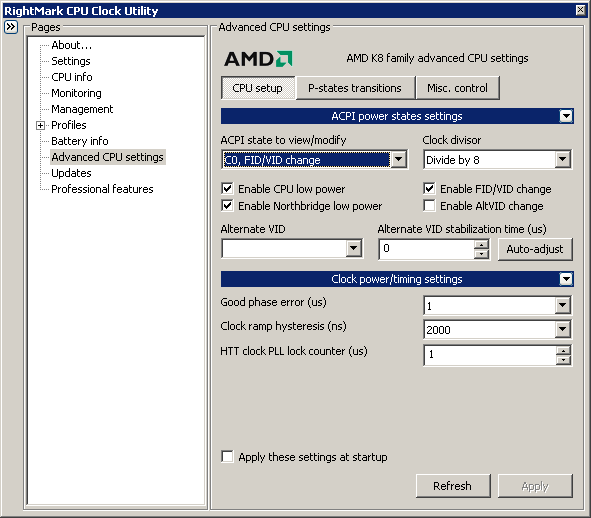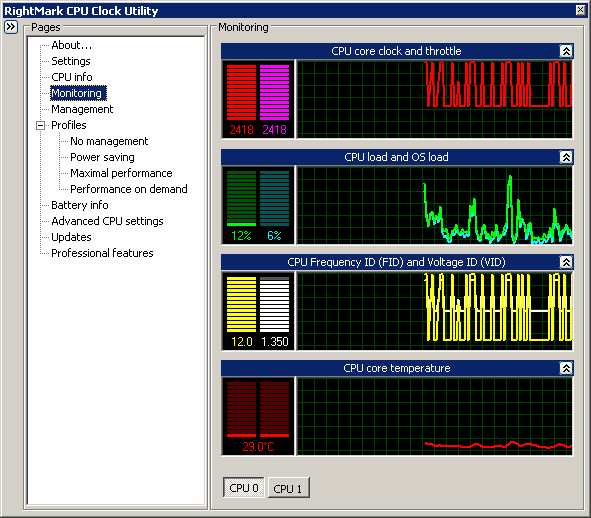Getting the Most Out Of Your Hardware: Motherboard/CPU Utility Roundup
by Ryan Smith on December 12, 2007 12:00 AM EST- Posted in
- Guides
Breaking the Rules - CPU Tweaking Through Power Management: RMClock
Last but not least, there are times where our opinion on matters and our advice can have the consistency of tapioca pudding, and this would be one of them. We recommend against motherboard tweaking utilities due to their poor design and spotty record, but this doesn’t mean that all hardware tweaking through software is a bad idea, only that we don’t like doing it though software controlling the motherboard. In a handful of cases we can manipulate the CPU directly, where the rules of the game change and there exists software we like.
Modern CPUs can exercise some control over their frequency, FSB/HT speed, and voltage through their power management features, exercising a small but reliable level of influence over the motherboard driving them. In turn, if we manipulate the CPU via software we can control the motherboard in this way, as a much safer and saner alternative to directly applying tweaks to the motherboard.

There are several utilities that offer this kind of tweaking (including CrystalCPUID of all things) but the RightMark CPU Clock Utility (RMClock) is by far the most through and up to date of these utilities, which is why we’re talking about it in particular. While non-enthusiast (read: expensive) processors are multiplier locked as far as going up, the same is not true for going down – they need to be able to use lower multipliers in order to slow the CPU down as part of their power management features. It’s this quirk that RMClock can exploit.
RMClock can override the default power management settings on a CPU, and both request new settings and forcefully engage these power saving modes. RMClock is still limited by the multiplier cap, but this in turn makes it possible to slow a processor down for whatever reason. The most popular uses for such a feature include forcefully keeping a CPU in a lower power state more often to maximize battery life on a laptop or minimize heat in a HTPC and forcing down the CPU clockspeed for some forms of stability testing without needing to reboot. It’s not a feature that everyone needs (if you need it, you’ll know) but it’s extremely handy when you do need it.

Due to its power management hooks, RMClock can also be used as a CPU monitoring application. Much of the information is redundant thanks to the combination of SpeedFan and CPU-Z, but there’s one thing RMClock can do that neither of those can that is handy for overclocking: throttling detection. Intel’s MCM quad-core processors are once again the biggest benefactor here because difference dice can have differing thermal characteristics, and while the current Q6xxx series is easy to overclock, it’s also easy to inadvertently push the limits on.
For initial overclocking trials having RMClock monitoring the CPU for any signs of throttling can expose a chip that is quietly throttling to keep a lesser die cool but not suffering any instability due to it. Generally speaking the safe temperatures for any CPU are well below the level that thermal throttling kicks in, but there are enough known cases of it kicking in even at only moderately high temperatures that checking for throttling at least once can be a good idea.










11 Comments
View All Comments
jtleon - Wednesday, March 12, 2008 - link
I know that such a guide may be a common item online, however, those other sites that claim to "optimize" an OS install are not running your many benchmarks on hardware. I would greatly appreciate seeing a comprehensive OS install guide (covering XP, Vista, perhaps even older operating systems like W2K).Regards,
jtleon
rADo2 - Friday, December 21, 2007 - link
Lavalys Everest Ultimate is an excellent infotool, it can also output its info to Logitech G15 LCD panel and/or Vista sidebar:http://lavalys.com/products/overview.php?pid=3&...">http://lavalys.com/products/overview.php?pid=3&...
Arctucas - Friday, December 14, 2007 - link
I never have used nTune because so many users who have used it report that it causes more problems than it is worth.Zak - Saturday, December 15, 2007 - link
I never had any real problems with nTune, except the built in stress test is clearly meant as a joke. Any machine I tried it with would almost always pass the nTune stress test for 10 minutes and then fail/lock up/crash during first few seconds of 3DMark** or any other utility or game.However, there is an issue that makes nTune kind of useless for me: the video card fan control settings don't get saved with profiles so after reboot the the overclocked profile loads but the fan defaults to its slow speeds so the card will overheat and your machine will crash during a game very quickly unless you manually set the fan to higher speed in nTune every time. Kinda annoying... Is there a solution for that, by any chance?
Z.
xsilver - Thursday, December 13, 2007 - link
I for one am sick of mobo makers not making any progress in this customization / tweaking area.For manufactuers to stand out from one another they have resorted to crazy looking heatpipe NB heatsinks when they could go another route.
After having owned an abit s939 board I found its uguru tweaking options to be excellent and stable. Being able to change voltages/FSB while in windows *WITHOUT REBOOT* this was key.
I have no idea why this is no longer available on my asus p5k dlx mobo. It keeps wanting to reboot after I change anything and it doesnt stick when I use it.
I would have thought it be extremely convenient to have a pc boot at low/standard voltages/FSB but then crank it up to max fsb/voltage when encoding/gaming/folding etc.
I would not hesitate to buy abit again if other manufacturers dont implement this feature in future motherboards (too bad abit doesnt have much market penetration and is hard to get here in australia)
jojo4u - Wednesday, December 12, 2007 - link
The crowd at SPCR hails RMClock for it undervolting options since you can control each step of CnQ/EIST instead of a global VID.Regardging the that Tjunction:
Btw, there's a fact with Intel CPUs which is often overlooked. The DTS reports how much the temperature is away from the throttling point. This point is variable for desktop CPUs. On top of it, you cannot read this value out. So DTS readings from different CPUs are useless since CoreTemp assumes 85 degree celsius most Intel desktop CPUs.
If you own a desktop Intel CPU, I would have a goal of staying at least 10 degree away from the throttling temperature. The new CoreTemp can output this delta.
See also: http://www.alcpu.com/forums/viewtopic.php?t=247">http://www.alcpu.com/forums/viewtopic.php?t=247
Intel mobile CPUs just report the temperature as "near" 85 or 100 degree celsius.
The actual value of the throttling point (PROCHOT_L) for AMD CPUs remains a complete mystery to me and will be part of my next experimenting
(from http://www.silentpcreview.com/forums/viewtopic.php...">http://www.silentpcreview.com/forums/viewtopic.php...
LEKO - Wednesday, December 12, 2007 - link
Thanks for this ocncise article, it will helps me, but mostly friends in their overclocking journey.These articles becomes "reference" when we teach overclocking to someone.
domg - Wednesday, December 12, 2007 - link
RMClock is a great application, no doubts about that. However, because of the latest restrictions imposed by Microsoft, there is absolutely no way of loading the UNSIGNED driver used by RMClock into Vista x64 unless you manually boot into development mode (every time). I would have liked to see something in the article about this, since there are a great many people out there who have been forced to go without use of RMClock for this very reason. If you search, you'll find that you can disable mandatory driver signing by uninstalling four Windows updates (KB932596, KB938979, KB938194, KB941649) and using bcdedit.exe to disable driver integrity checks. However, this should not be necessary and it would be nice to see the developer get on track with this after several months of known incompatibility.nullpointerus - Wednesday, December 12, 2007 - link
From what I've read, you can sign your own drivers:http://www.hauppauge.co.uk/board/showpost.php?p=60...">http://www.hauppauge.co.uk/board/showpost.php?p=60...
goinginstyle - Wednesday, December 12, 2007 - link
"NVIDIA and now AMD are taking a stab at the issue, but it has yet to be enough. Both are quite capable of the task and we hope to one day see the motherboard situation rival that of the video card situation."Have you tried AMD's new AOD utility? It still has a few issues but addresses just about all of your concerns with the mb utilities plus adds a few features that are not on the video card tuners.